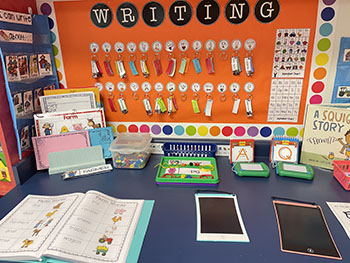Organization and Routines in Prekindergarten Classrooms
Children can thrive in the prekindergarten classroom when there is an organized environment, orderly routine, and overall structure where instructional time is maximized, and children learn to work independently in a supported environment. A well-organized classroom with well-prepared activities helps children expand their attention span and build self-control and personal responsibility while supporting children’s self-regulation, overall well-being, and receptiveness to learning.
The following elements should be evident in effective prekindergarten classroom organization:
- Classroom norms (e.g., looking eyes, listening ears)
- Classroom procedures (e.g., fire drill, arrival/dismissal)
- Color-coding and labels in learning centers and other pertinent areas of the room (e.g., restroom) in languages applicable to the classroom (e.g., a bilingual program will have labels in both English and Spanish)
- Labeled objects with print/picture for identification (e.g., cubbies, focus wall)
- Visual scaffolds (e.g., how to wash your hands)
- Visual daily schedule for students and visitors
- Posted weekly activity/lesson plans for staff reference
Visual and accessible (interactive and eye-level) information such as charts, choice boards and focus walls, can also help with the order of the daily routine, and allow children to use print in a meaningful way. When these supports are used consistently, children feel secure in knowing what the prekindergarten day brings. Adaptations can be used based on the classroom type and needs of the children (e.g., PK3 real photos of routine with print- PK4 photos or clipart of routines with print).
Visual Organization in the ECE Classroom
- Daily schedule chart: When given an interactive, accessible (e.g., eye-level) daily schedule, children have an opportunity to explore the passage of time within the day and visually plan their routine at any given time. This also includes the opportunity for children to connect pictures to printed words.
- Attendance chart: An interactive attendance chart can be intentionally used to promote self-awareness (e.g., sign-in sheet, checking in with the questions of the day), peer recognition, and identification of letters/words (e.g., peer names).
- Helper's chart: Aspects of the daily routine can promote social competence by providing opportunities for children to help with classroom tasks. Creation and usage of the helper chart on a consistent basis also helps children understand the importance of responsibility and classroom management.
- Learning center planning chart or choice board: These charts have words and pictures to illustrate the purpose of each learning area. The charts provide children with an opportunity to make choices and to actively participate in their own learning. Each planning chart can include the name of the learning area or a picture icon representing the area.
- Concept charts: These interactive charts may be skill or theme related, with intentional use of pictures and print. They should be created with the children and be available for students to reference throughout the day (e.g., data graph, circle map, vocabulary list).
- Letter/word walls: These types of focus walls support print-rich environments that can be used in prekindergarten-second grade classrooms to promote increasing vocabulary, word identification (e.g., child’s name), and alphabet knowledge skills.
See CLI for exemplars and resources.




